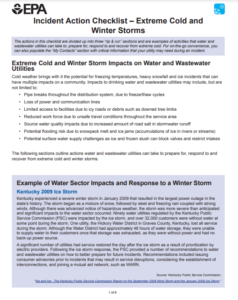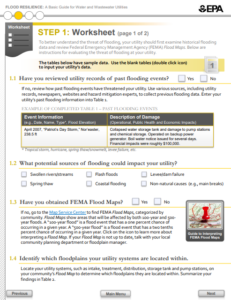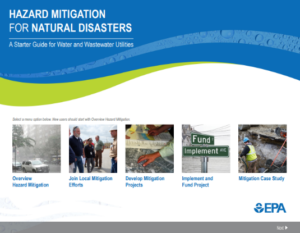Don’t Get Left Out in the Cold: Enhance Winter Weather Resilience with Mitigation
By: Gabrielle Minton, Physical Scientist, U.S. EPA
The services provided by drinking water and wastewater utilities are vital to the health and resilience of a community. However, extreme winter weather, including floods, blizzards, and ice storms, can present challenges to maintaining drinking water and wastewater services, underscoring the need for long-term resilience solutions in the water sector.
The National Oceanic and Atmospheric Administration’s (NOAA) forecast[1] for the 2020-2021 winter season predicts warmer, drier conditions in the southern tier of the United States and colder, wetter weather across the northern tier, due in part to an ongoing La Niña. To better prepare for the upcoming winter season, your utility can take steps before, during and after winter weather events using the U.S. Environmental Protection Agency’s (EPA) suite of easy-to-use tools and resources.
Prioritize Your Utility
The winter season can bring freezing temperatures, heavy snowfall, ice, and flooding. These conditions can cause power loss and infrastructure damage, such as pipe breaks and flooded facilities. The EPA has developed the Extreme Cold and Winter Storms Incident Action Checklist (IAC) to help utilities prepare for, respond to and recover from extreme winter weather events.

The planning measures outlined in the Extreme Cold and Winter Storm IAC encourage utilities and community partners to work together before potential incidents to plan for power restoration, plowing, and road salting or sanding. Making sure your utility has priority can keep your staff safe and ensure customers have a reliable source of water before, during, and after a disaster. Similarly, confirming your utility’s response access credentials with local law enforcement before an incident can make all the difference when staff are urgently needed to restore facility operations.
Steps Toward Resilience: Understand Threats, Identify Vulnerabilities, and Determine Consequences
Floods are one of the most common and widespread weather-related incidents. They can be caused by a variety of weather events, including rains that follow significant snow and ice accumulation. EPA developed the Flood Resilience Guide: A Basic Guide for Water and Wastewater Utilities for your utility to use to minimize damage and rapidly recover from disruptions to service. The Flood Resilience Guide presents a four-step process for building resilience to winter-related flooding emergencies.
For each step, the Guide provides worksheets outlining actions your utility can take to prepare for, respond to, and recover from winter season floods. These actions can include reviewing utility records of past flooding events to determine the magnitude of threat to your utility and identifying the specific causes of past flooding incidents, such as ice jams or snow melt. These steps will ensure the mitigation measures are economical, practical, and effective at protecting your utility and customers.

Transform Preparedness into Mitigation
While preparedness measures can strengthen your utility’s resilience to extreme winter weather, putting long-term mitigation planning for incidents into practice is the most effective way to ensure your utility and community can better withstand and recover from disasters. To assist planning for long-term mitigation projects, EPA’s Hazard Mitigation Guide for Natural Disasters provides examples of mitigation projects for disaster scenarios that drinking water and wastewater utilities may encounter during a winter storm, such as purchasing or renting a generator to prepare for winter season power outages and elevating wellheads to mitigate the impacts of flooding from snow melt or ice jams. The Guide encourages drinking water and wastewater utilities to work with their local mitigation planners to execute priority projects that are consistent with the overall community strategy.
The Hazard Mitigation for Natural Disasters Guide also includes information on eligibility for funding, such as federal grants or loans, to support mitigation work. This includes the Federal Emergency Management Agency’s (FEMA) Hazard Mitigation Grant Program (HMGP) which can be used by communities to implement hazard mitigation projects following a Presidential Disaster Declaration.

Identify Federal Funding Opportunities for Mitigation
There are several federal programs, including HMGP to help utilities understand and obtain federal disaster and mitigation funding. EPA developed the Federal Funding for Water and Wastewater Utilities in National Disasters (Fed FUNDS) tool so that utilities can quickly screen funding programs from U.S. Department of Housing and Urban Development, U.S. Department of Agriculture, Small Business Association, FEMA and EPA to identify those that are applicable to your utility. It also provides examples of successful utility applications and tips for funding.
Consolidate Information in an Emergency Response Plan
Another key aspect in planning for and responding to winter weather incidents is developing a robust Emergency Response Plan (ERP). An ERP describes strategies, resources, plans, and procedures to prepare for and respond to a natural occuring or man-made incident. Under America’s Water Infrastructure of 2018 (AWIA) Section 2013, community water systems serving over 3,300 people are required to develop or update an ERP. The information, plans and procedures developed when utilizing the Extreme Cold and Winter Storms IAC, Flood Resilience Guide and Hazard Mitigation Guide for Natural Disasters contribute to the foundation of your ERP. Compiling this information provides a clear and concise process for emergencies and fosters a culture of preparedness at your utility.
Interesting in Learning More?
To learn more, visit www.epa.gov/waterresilience or join the What’s Going On newsletter email list by contacting [email protected]. With the help of EPA’s free water resilience resources, you can help ensure that your utility continues to provide safe and reliable services to your customers during emergencies.
[1] “U.S. Winter Outlook: Cooler North, Warmer South with Ongoing La Nina.” U.S. Winter Outlook: Cooler North, Warmer South with Ongoing La Nina | National Oceanic and Atmospheric Administration, 15 Oct. 2020, www.noaa.gov/media-release/us-winter-outlook-cooler-north-warmer-south-with-ongoing-la-nina.
